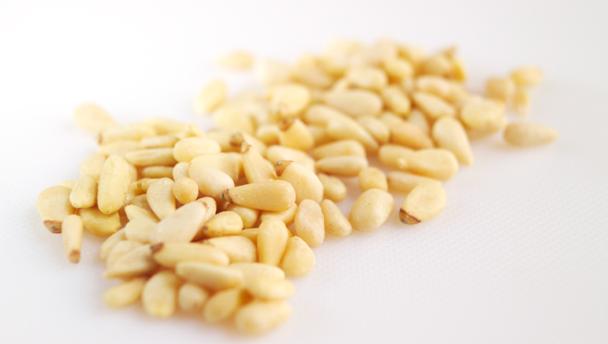

Probably best known for their use in pesto sauce, pine nuts have a very delicate taste and texture and are high in protein which makes them especially useful in a vegetarian diet. They can be eaten raw, when they have a soft texture and a sweet buttery flavour and are especially good in salads. They are delicious toasted as this brings out their flavour and adds a little extra crunch.
 Tom Kerridge’s butternut squash and sage risotto
Tom Kerridge’s butternut squash and sage risotto
 Express bacon and pesto pasta
Express bacon and pesto pasta
 Chicken with chorizo, peppers and sage with spiced aubergine
Chicken with chorizo, peppers and sage with spiced aubergine
 Quick sausage casserole with Savoy cabbage pesto
Quick sausage casserole with Savoy cabbage pesto
 Basic tortellini with ricotta and pine nuts
Basic tortellini with ricotta and pine nuts
 Pesto lemon chicken
Pesto lemon chicken
 Kid’s customised couscous salad
Kid’s customised couscous salad
 Spinach, feta and pine nut salad
Spinach, feta and pine nut salad
 Honey and chestnut cake
Honey and chestnut cake
 Gluten-free Venetian carrot cake
Gluten-free Venetian carrot cake
 How to make pesto
How to make pesto
Pine nuts are oily and rich in protein, so they tend to go rancid quite quickly; store them in the fridge and they will keep longer.
The longer, thinner Asian varieties are higher in oil than American or Mediterranean types. Pine nuts have a rich buttery, resinous flavour and are used in many savoury dishes, especially vegetarian ones, but are particularly associated with Italian, Mediterranean and Asian cooking. They’re a key ingredient in pesto and appear in lots of pasta dishes.
Type the ingredients you want to use, then click Go. For better results you can use quotation marks around phrases (e.g. "chicken breast"). Alternatively you can search by chef, programme, cuisine, diet, or dish (e.g. Lasagne).